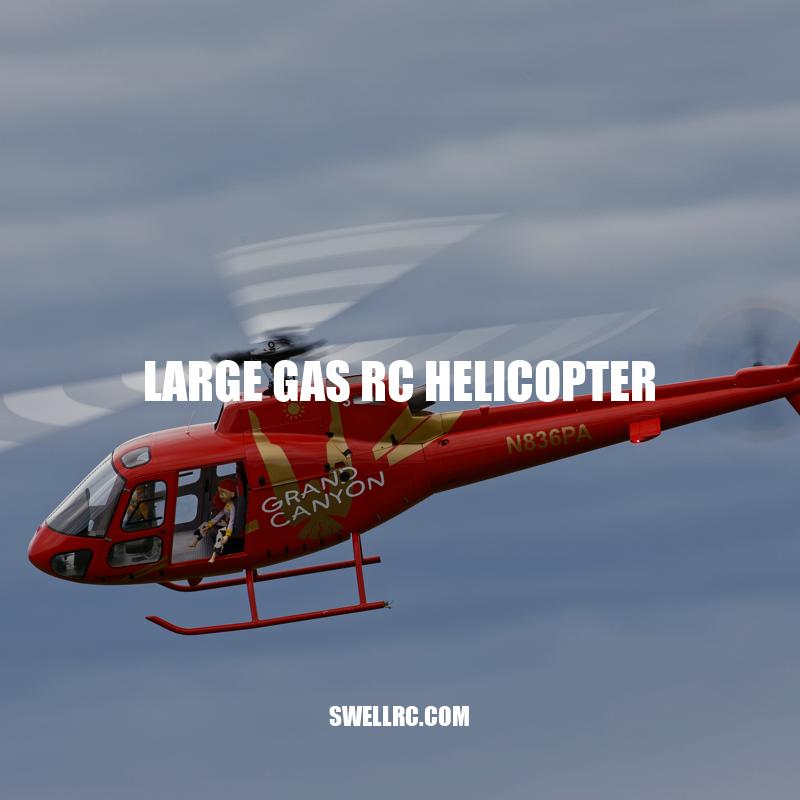Exploring Large Gas RC Helicopters: Power, Performance, and Maintenance
Large gas RC helicopters are a popular choice among hobbyists who are passionate about aviation and love to explore the skies. These high-powered aircrafts rely on gasoline to fuel their engines, which enables extended flight times and greater maneuverability. Compared to their electric counterparts, gas-powered helicopters offer more power, speed, and control, making them a favorite among experienced pilots. They are also available in different sizes which cater to pilots of all skill levels, from beginners to seasoned pros. The versatility and performance of these helicopters make them ideal for acrobatic flying, aerial photography, and other recreational activities. However, owning a large gas RC helicopter requires proper maintenance, care, and knowledge of safety regulations. In this article, we will discuss the technical aspects of these powerful machines, the care and maintenance procedures, and the protocol that must be followed for safe flying.
Engine and Fuel
The engines used in large gas RC helicopters are typically two-stroke gasoline engines. These engines offer smoother running performance, greater reliability, and higher power than their electric counterparts. Here are some key points to keep in mind when considering engines and fuel for your gas-powered helicopter:
- Selecting the right fuel: Gasoline or gas/oil mixtures are commonly used to power gas RC helicopters. Choosing the right fuel for your helicopter is essential in ensuring the engine’s longevity and performance. Check your helicopter’s manual or consult your supplier to determine the recommended fuel mixture ratios.
- Maintenance: Proper engine maintenance and care play critical roles in ensuring that your gas-powered helicopter operates optimally. Regular oil changes, spark plug replacements, and cleaning of the engine and carburetor can make a significant difference in the performance and lifespan of your engine.
- Performance: Gas-powered helicopters have the advantage of being more powerful than electric ones, which means they can reach higher altitudes and perform more complex maneuvers.
For those who are just starting out, it is best to get advice from experienced pilots or join a local RC helicopter club. Websites such as Rotor Riot and RC Groups offer helpful forums and resources for pilots of all levels. Additionally, there are a variety of gas-powered RC helicopters available on websites such as Horizon Hobby and XHeli that cater to different skill levels and personal preferences.
What kind of fuel does a RC helicopter use?
Remote control helicopters can use different types of power sources depending on the model. The most common types of fuel used are glow fuel (nitromethane-methanol), electric batteries, gasoline, and turbine engines. For many years, glow fuel helicopters were the most popular type produced. If you’re interested in purchasing an RC helicopter, it’s important to research the model’s fuel requirements before making a purchase.
Large gas RC helicopters range in size from 50 to 800 class. The size of the helicopter is determined by the length of its rotor blades, with larger blades providing more lift and stability. Here are some key points regarding size and power that you should consider before purchasing a large gas RC helicopter:
- Size: The size of the helicopter determines its flight characteristics, handling, and portability. Consider where you plan to fly before selecting a size. Larger helicopters may require more space and can be challenging to transport, while smaller ones can be flown both indoors and outdoors and are more compact.
- Power: Gas-powered helicopters tend to be more powerful than electric ones. The power of a gas helicopter is measured in cubic centimeters (cc), with larger engines producing more power. A larger engine can offer a better flying experience, but it also requires more fuel and can be more expensive.
- Performance: With increased size and power, gas-powered helicopters have the advantage of being able to perform more complex maneuvers and aerobatics. Additionally, gas-powered helicopters are better suited for outdoor flying in windy weather conditions.
To help you compare different sizes and power options, here is a table showing the recommended size range and power of gas-powered RC helicopters based on the skill level of the pilot:
| Pilot Skill Level | Recommended Size Range | Recommended Engine Size (cc) |
|---|---|---|
| Beginner | 50-100 class | 20-30 cc |
| Intermediate | 300-500 class | 50-60 cc |
| Advanced | 600-800 class | 90-120 cc |
Websites such as HeliDirect and Horizon Hobby offer a variety of gas-powered RC helicopters that cater to different skill levels and preferences. It is always advisable to consult with experienced pilots or join local RC helicopter clubs to determine the appropriate size and power helicopter for your skill level and intended use.
What are the sizes of RC helicopters?
RC helicopters come in various sizes, ranging from micro (under 200mm main blades) to mini (240-420mm blades), 500 (425-500mm), 600 (600mm), 700 (standard competition size), and 800. Different sizes offer different levels of stability, maneuverability and power. You can find information on different sizes and models of RC helicopters on websites such as Horizon Hobby and Blade.
Large Gas RC Helicopter:
If you’re looking for a large gas-powered RC helicopter, there are several factors to consider before making a purchase. These helicopters offer longer flight times and greater ranges than smaller models, but they also require more skill to operate and can be more expensive.
When choosing a large gas RC helicopter, it is important to consider the size, weight, and power of the model. Some popular large RC helicopters on the market include the Blade 600X, the Thunder Tiger Raptor E700, and the Align T-Rex 700X. Motion RC offers a selection of large gas RC helicopters from different brands.
Flight time and range are important factors to consider when choosing a gas-powered RC helicopter. On average, large gas-powered helicopters offer flight times of around 15-20 minutes per tank of fuel, but these can be extended with the use of a larger fuel tank or a more fuel-efficient engine. Range can vary depending on the type of antenna used, but larger helicopters can typically reach ranges of up to 1,000 feet or more.
To improve flight time and range, pilots can take several steps:
- Use a more fuel-efficient engine or a larger fuel tank
- Adjust the pitch and throttle settings to reduce fuel consumption
- Avoid flying in gusty or windy conditions, which can affect stability and fuel consumption
- Maintain the helicopter regularly to ensure optimal performance and fuel efficiency
When purchasing a large gas RC helicopter, it’s important to carefully research and compare different models to ensure that you find the one that meets your specific needs and preferences. Additionally, be sure to follow all safety guidelines and regulations when operating your helicopter.
How long can a helicopter fly on a tank of gas?
Most helicopters can fly for 2.5 to 5 hours on one tank of gas, which means a range of 320 to 640 km approximately. However, the exact range varies depending on the type of helicopter. For more information, you can visit aviation-related websites like www.flyingmag.com or check products like fuel management systems from companies like ForeFlight.
Maintaining and caring for a large gas RC helicopter is essential for optimal performance and longevity. Here are some tips to keep your helicopter in top condition:
- Regular cleaning: Use a soft brush or cloth to remove dust, dirt, and debris from the helicopter’s surface and parts. Avoid using harsh chemicals or abrasive materials that can damage the paint or delicate components.
- Lubrication: Use a light oil or spray lubricant to lubricate moving parts such as the gears, bearings, and rotor system. This helps reduce friction and wear, and prolongs the life of the helicopter.
- Part replacement: Check the helicopter’s parts regularly for signs of wear and tear, and replace damaged or worn parts as soon as possible. This can include the blades, tail rotor, landing gear, and other components.
- Proper storage: Store your helicopter in a cool, dry place away from direct sunlight and humidity. Keep the fuel tank empty or use a fuel stabilizer to prevent corrosion and damage to the engine and fuel lines.
Regular maintenance and care can prevent costly repairs (large gas RC helicopters can be expensive) or replacement of the helicopter. Here are some recommended maintenance intervals:
| Maintenance Task | Recommended Interval |
|---|---|
| Cleaning | After every flight |
| Lubrication | Every 10-15 flights |
| Part Replacement | As needed or every 50 flights |
| Fuel system check | Every season or every 6 months |
Websites such as Amazon and HobbyKing offer a wide range of maintenance and replacement parts for large gas RC helicopters. It is recommended to purchase from reputable brands and sellers to ensure the quality and compatibility of the parts.
How do you charge a RC helicopter?
To charge your RC helicopter, first, you need to turn off the helicopter. Then, locate the charging port on your helicopter and plug the charger into the port. Make sure to connect the charger to a power source and wait for the battery to fully charge. It is essential to follow the manufacturer’s instructions specific to your helicopter model. You can also find some helpful videos demonstrating how to charge an RC helicopter on websites such as YouTube. One such video can be found at https://www.youtube.com/watch?v=OSy2wyf-H4Q.
Flying a large gas RC helicopter comes with potential risks that can harm yourself, others, or property. Here are some safety precautions to follow:
– Read the manual: Familiarize yourself with the helicopter’s features, controls, and safety guidelines before operating it.
– Select a safe flying area: Choose a wide-open space away from people, buildings, trees, or power lines. Avoid flying near airports or restricted areas.
– Check the helicopter before each flight: Inspect the helicopter’s parts, fuel system, and battery for any damage or malfunction. Ensure that the weather conditions are suitable for flying.
– Ensure visibility: Keep the helicopter in sight at all times and avoid flying it too high or too far from your position. Use bright colors or LEDs to help you see the helicopter’s orientation.
– Be aware of the surroundings: Watch out for potential obstacles or hazards that can affect the helicopter’s flight path. Be prepared to take immediate action if necessary.
In addition to safety precautions, there are also Federal Aviation Administration (FAA) guidelines that apply to RC aircraft. Here are some of the regulations:
– Only fly for recreational purposes: Do not use RC helicopters or other unmanned aircraft for commercial purposes.
– Keep the helicopter within visual line-of-sight: The operator must maintain visual contact with the helicopter at all times. Use an observer if necessary.
– Fly below 400 feet and away from airports: Do not fly the helicopter above 400 feet above the ground or within 5 miles of an airport without prior authorization.
– Do not interfere with manned aircraft: Avoid flying the helicopter near or in the path of full-scale aircraft. Yield to any oncoming traffic.
Websites such as the FAA and Academy of Model Aeronautics (AMA) provide detailed guidelines and resources for RC aircraft operators. It is recommended to follow these guidelines to ensure safe and legal operation of a large gas RC helicopter.
How to learn to fly a helicopter?
To learn to fly a helicopter, one must be at least 18 years old, hold a private pilot license, and hold an FAA medical certificate. Additionally, one must complete ground instruction, pass FAA written, oral, and practical tests, complete 20 hours of dual flight training, and complete one dual cross-country flight. There are several flight schools and online resources that offer helicopter flight training, including ATP Flight School, Helicopter Online Ground School, and Sporty’s Academy.
Conclusion
In conclusion, a large gas RC helicopter is a fun and challenging hobby that can bring hours of enjoyment for enthusiasts. However, it’s important to keep safety as a top priority when operating this type of aircraft. By following safety precautions and FAA regulations, you can minimize the risks of accidents or injuries.
Additionally, proper maintenance and care can help prolong the lifespan of your helicopter and keep it running smoothly. Be sure to do your research before purchasing a large gas RC helicopter, as there are many options available with different features, sizes, and price ranges.
Overall, if you’re looking for a thrilling and unique hobby, owning a large gas RC helicopter may be the perfect choice for you. Just remember to fly responsibly and have fun!



